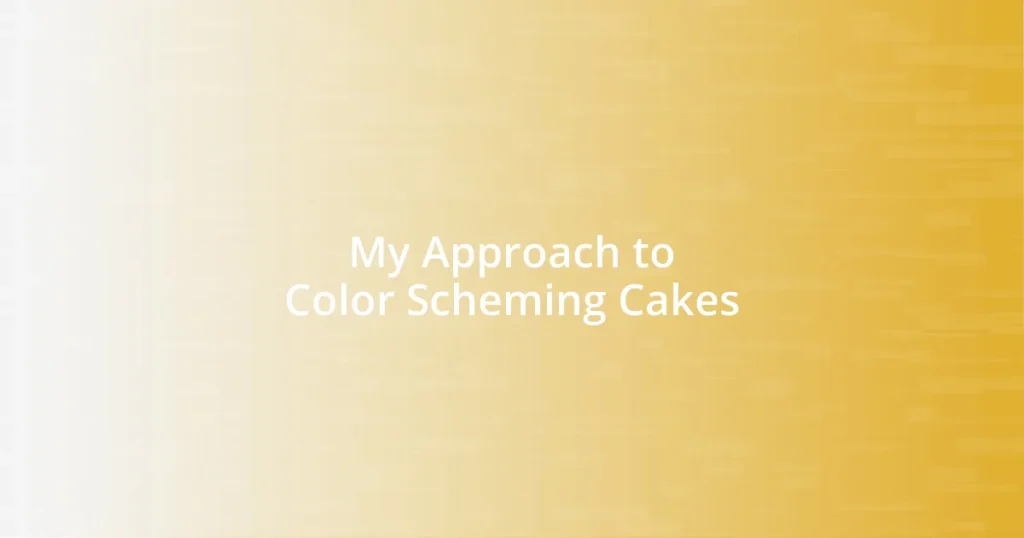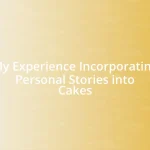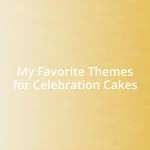Key takeaways:
- Understanding color theory enhances emotional connection and storytelling in cake design, with different colors evoking specific feelings.
- Choosing complementary and analogous color palettes aligns cakes with event themes, while texture and layering add visual interest and depth.
- Incorporating edible decorations, such as flowers and sprinkles, elevates the cake’s appeal and adds personal touches for memorable experiences.
- Final presentation touches like edible glitter, personalized cake toppers, and contrasting cake boards make a significant impact on overall aesthetics.

Understanding Color Theory Basics
Color theory is fascinating because it dives into how colors interact with each other and influence our emotions. For instance, have you ever walked into a bakery filled with pastel shades and felt instantly calm? That’s the magic of soft colors—they evoke feelings of serenity and sweetness, which is exactly what I aim for when designing a cake.
When I was experimenting with a tropical-themed cake for a friend’s birthday, I learned quickly about complementary colors. I paired vibrant oranges and blues, creating a visually stunning effect that made the cake feel vibrant, just like a sunny beach day. The right color combinations can elevate your creations beyond mere dessert; they can tell a story.
Thinking about color temperature is also crucial. Warm colors like reds and yellows bring energy, while cool colors such as greens and blues provide a sense of tranquility. Reflecting on my own experiences, I find that choosing the right temperature for a cake can completely alter the atmosphere of an occasion. Have you noticed how some cakes ignite excitement while others bring a sense of calm? It’s all about understanding the basics of color theory.

Choosing Color Palettes Effectively
Choosing the right color palette for cakes is like selecting the perfect outfit for a special occasion; it has to resonate with the mood you want to create. I remember a time when I crafted a wedding cake and struggled with colors. I decided on ivory, blush pink, and gold accents, which not only complemented the bride’s theme but made the cake feel both elegant and timeless. This experience taught me how vital it is to align the color palette with the event’s emotional tone.
One approach I often recommend is exploring analogous colors—those that sit next to each other on the color wheel. This method creates a harmonious blend that feels safe yet sophisticated. For instance, a cake adorned with soft blues, greens, and teals can evoke feelings of calmness, perfect for a spa-themed gathering. It’s amazing how taking these elements into consideration can transform your cake from simply looking good to making a statement.
When I consider my creative process, I observe how color plays a significant role in storytelling. Recently, I was inspired to bake a cake for a cozy autumn gathering. I chose deep oranges, browns, and warm whites to mirror the changing leaves and the comfort of the season. Seeing the joy it brought to my friends reminded me that color choices can nurture connections and evoke nostalgia. It’s all about curating a palette that resonates personally and enhances the experience.
| Color Scheme | Emotional Impact |
|---|---|
| Pastels | Serenity and sweetness |
| Vibrant Colors | Energy and excitement |
| Analogous Colors | Harmony and sophistication |
| Warm Tones | Comfort and warmth |

Matching Colors with Themes
Matching colors with themes can truly transform a cake into a focal point of an event. I remember planning a surprise birthday cake for my sister’s garden party. I carefully chose shades of lavender, soft greens, and whites, which beautifully reflected the floral arrangements and the overall serene outdoor vibe. This experience highlighted to me how specific colors can enhance the thematic elements of an occasion, offering a cohesive visual experience.
Here’s a quick guide to consider when selecting colors for your cake themes:
- Elegant Affairs: Opt for muted tones like ivory, blush, or soft gold to add sophistication.
- Festive Celebrations: Bright and bold colors, such as reds and oranges, can spark joy and excitement.
- Nature-Inspired Themes: Earthy colors like browns and greens evoke warmth and connection to the outdoors.
- Seasonal Themes: Use colors like deep oranges and browns in fall to reflect the changing foliage and warmth of the season.
- Whimsical Themes: Playful colors, like pastel pinks and yellows, can create a fun and light-hearted atmosphere.
Colors can speak volumes about the event’s theme, and I’ve found that aligning the cake’s colors with the overall decor not only pleases the eye but also enhances the emotional experience for everyone involved.

Techniques for Applying Colors
When it comes to applying colors on cakes, I really enjoy the technique of airbrushing. I remember the first time I tried it on a practice cake; the smooth gradient between colors was mesmerizing! Using an airbrush allows for a soft and seamless blend that can bring depth and dimension to your design. Have you ever looked at a cake and thought the colors seemed to flow effortlessly? That’s the magic of this technique—it’s both an art and a science.
Another approach I frequently utilize is painting with food color gels. I once created a stunning marbled effect on a buttercream cake, using a combination of gel colors and a small brush. It was rewarding to see how a little artistry with the brush could transform an ordinary cake into a canvas! This method gives you the freedom to express your creative flair, making it suitable for both intricate designs and sleek finishes.
Then there’s the fun of mixing colors directly into your frosting. When I made a rainbow sprinkle cake for a friend’s child’s birthday, swirling vibrant colors into the buttercream brought back such joyful memories! Initially, I poured in too much color and learned quickly about the balance; as I adjusted, I realized how mastering this technique can create a delightful surprise in each slice. Who wouldn’t smile at the sight of a colorful cross-section? Every technique you choose can tell a story, and I encourage you to explore what suits your style best.

Tips for Layering and Texture
When it comes to layering, I always emphasize the importance of even distribution. I learned this the hard way during my first attempt at a layered cake where one side ended up too tall, almost like a leaning tower! To prevent this, I measure and level the layers diligently—using a cake leveler has become a game-changer for me. Getting those layers right not only improves the look but also the taste, as every bite should deliver a delightful balance of flavors.
Texture plays a crucial role in creating visual interest, and I personally enjoy incorporating elements like crispy praline or crunchy cookie crumbles between layers. The contrast can really elevate the experience. I still remember the joy of biting into a layer cake that had a surprising crunch—it made the cake feel more dynamic! Have you ever thought about how texture can evoke emotion? It certainly does for me, adding depth to each slice and turning a simple cake into a memorable one.
In my experience, adding a final touch with colored buttercream or fondant can enhance both layering and texture. I recall making a tiered cake where I used a spackling technique with buttercream to create a textured finish. The result was stunning, transforming what could have been a flat surface into a vibrant, tactile wonder. I often ask myself: how can I make this cake not just a treat for the taste buds but also for the eyes? Exploring texture is a journey, and the satisfaction from seeing your ideas come to life is absolutely rewarding.

Incorporating Edible Decorations
Incorporating edible decorations can really take your cake design to the next level. I remember the first time I worked with edible flowers—trust me, they’re a game changer! I placed vibrant pansies and roses on a vanilla buttercream cake for a spring celebration, and the visual impact was stunning. They not only added color but also a touch of elegance, making the cake feel special and festive. Have you ever imagined how fresh elements can breathe life into your creations?
When it comes to sprinkles, the variety available is both thrilling and overwhelming. I once experimented with themed sprinkles for a Halloween cake, using spooky shapes and colors that made the cake look like it jumped straight out of a fun storybook. It brought such joy to the kids (and the adults!) at the party. Selecting the right edible decorations can evoke nostalgia and excitement—what decorations remind you of your favorite celebrations?
Chocolate is another delightful option. I recall melting chocolate and drizzling it over a cake, creating beautiful patterns that not only enhanced the visual appeal but added a rich flavor. The glossy finish was irresistible, and I can still hear my friend’s excited gasp when she saw it. How thrilling is it to see your decorations not only enhance but completely transform the cake? Each edible decoration tells a story, adding layers of meaning to your sweet creations.

Final Touches for Stunning Presentation
One of my favorite final touches is the shimmer of edible glitter or gold leaf. I remember the first time I dusted a cake with a sprinkle of edible glitter—it felt like magic! The way it caught the light and added a dazzling effect was simply enchanting. Have you ever considered how that little sparkle can elevate a cake from ordinary to extraordinary?
I also cannot underestimate the impact of a well-placed cake topper. Recently, I crafted a birthday cake adorned with a personalized wooden topper that resonated deeply with the celebrant’s interests. It was a thoughtful touch that tied the whole design together, and I could see the joy it brought. Don’t you think something as simple as a cake topper can express so much? It personalizes the experience and makes each cake genuinely special.
Finally, I’ve learned that the color of the cake board can make a significant difference. I once opted for a contrasting color to complement a pastel cake, creating a chic foundation that made the entire presentation pop. When the cake was revealed, it was instant gratification; the colors just seemed to dance together. How do you feel about using color in unexpected ways? It’s these details that really draw the eye and leave a lasting impression.















